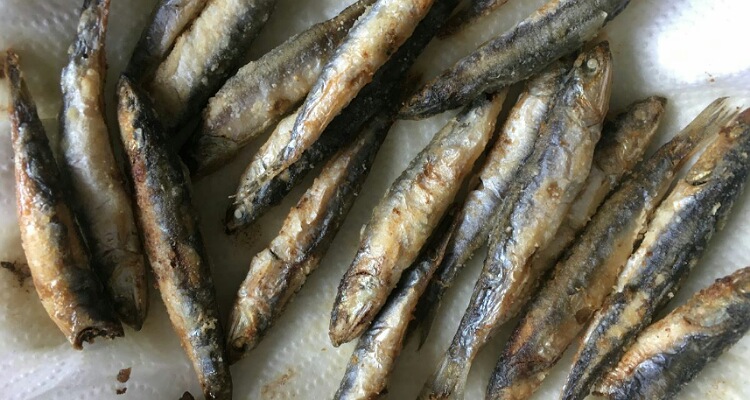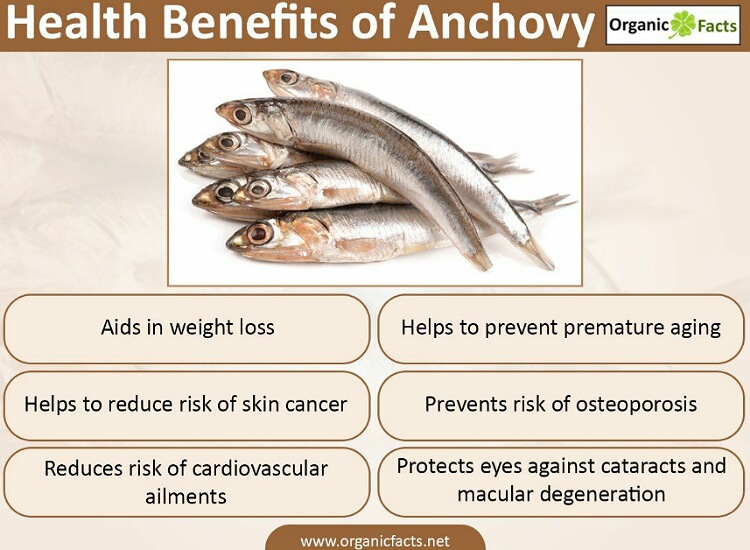Anchovies are small, oily fish belonging to the family Engraulidae. Most of these are from marine waters. There are many species of them and they are edible.
What is their nutritive value? Are there any health benefits associated with their intake in daily diet? What side effects can occur in the eater?
Anchovies
Anchovies are a variety of small fish that are in the category of oily fish. Their size ranges from 8 to 32 cm. Very few are more than 20 cm in length.
They belong to the family of Engraulidae which has 140 species of these fish. Most are found in the Atlantic and Pacific oceans and also in the Black Sea and the Mediterranean Sea.
Most of the species are in marine waters. Some might be from Brackish waters and very few are found in fresh waters.

These fish are silvery, slender, and salty. Hence they have a briny taste and are available in cans and tins. Some are also smoked, dried, or salted.
These fish are a staple of the foods of humans since ancient times. In Ancient Rome, they were valued as a condiment. Their prominence rose when in the 1990s, people started preferring these fish for pizza toppings.
But after a brief pause in their popularity, these fish are again made into the recommended list of top chefs, dietitians, and doctors.
Nutritive value
A three-ounce serving of this fish provides 111 calories. It has 17 grams of proteins and 4 grams of fats. There are no carbs or sugars. But there is no fiber either.

As per the USDA data, 100 grams of this fish has 210 calories. There are 29 grams of protein and 10 grams of fat out of which saturated fats are 2.2 grams.
There is also 85 mg of cholesterol in it. But the sodium content is a whopping 3668 mg. While potassium is 544 mg. It has iron and calcium along with vitamin B6, vitamin D, cobalamin, and magnesium.
Read more: Fish consumption and malignant melanoma: the likely association
Health benefits and downsides
These fish have high nutritive value just like the other oily fish. This is due to their high levels of omega-3 fatty acids. These fatty acids have a major role in heart and brain protection.
These fatty acids lower blood triglyceride levels and slow the process of plaque formation in the major arteries of the body including the coronary arteries that supply blood to the heart.
The fish has a role in reducing high blood pressure and can prevent stroke.

The fish has a lot of selenium. 1 serving provides 31 micrograms of it. This is important for the proper functioning of an enzyme that produces thyroid hormone.
The deficiency of selenium can cause thyroid problems. Selenium also has some role in cancer prevention.
These fish also promote eye health. They have eicosapentaenoic acid (EPA) and docosahexaenoic acid (DHA) in ample quantities.
These lower the incidence of macular degeneration which can diminish vision. Studies from Harvard Medical School have also shown that people who consumed omega 3 fatty acids have lower levels of the protein beta-amyloid.
This is a marker of Alzheimer’s disease. Hence this fish which has high levels of omega 3 fatty acids can lower the risk of this cognitive decline and protect the brain.
But due to the high salts, these fish can cause a rise in blood pressure. They might be contaminated with a substance called domoic acid. This leads to amnesic shellfish poisoning in the consumer.
The symptoms are nausea, vomiting, stomach upsets, loose motions, confusion, memory loss, and disorientation. Raw fish might have the fish parasite called Anisakis simplex. Sometimes, it might cause allergies in some people.